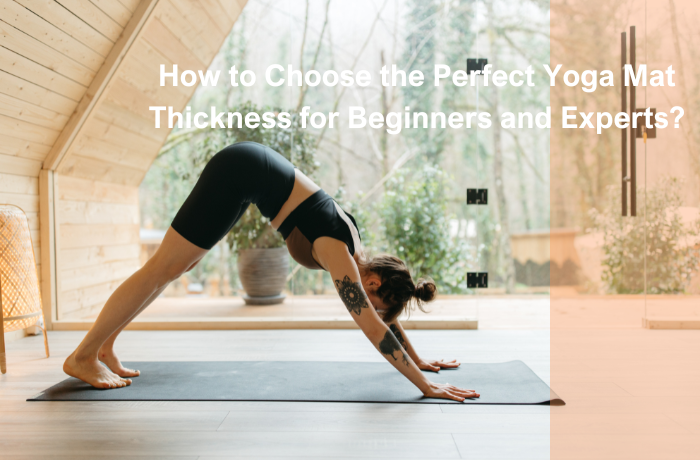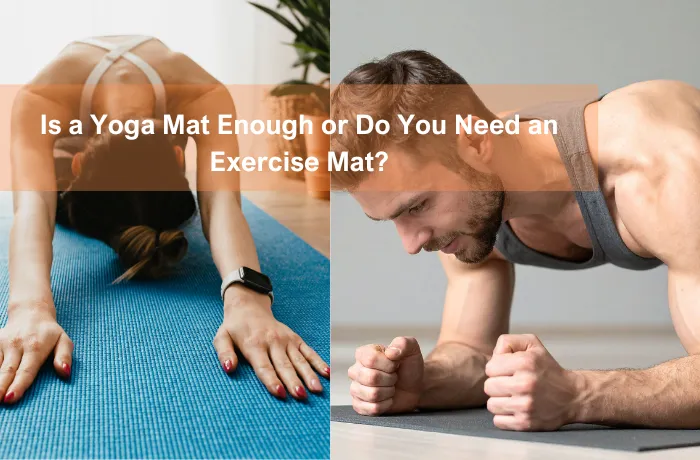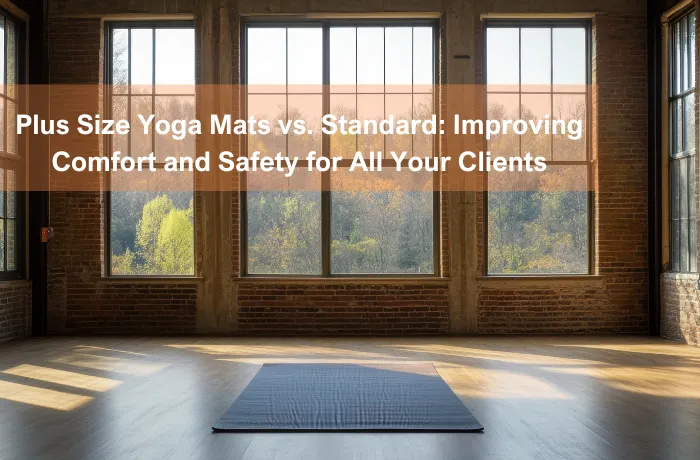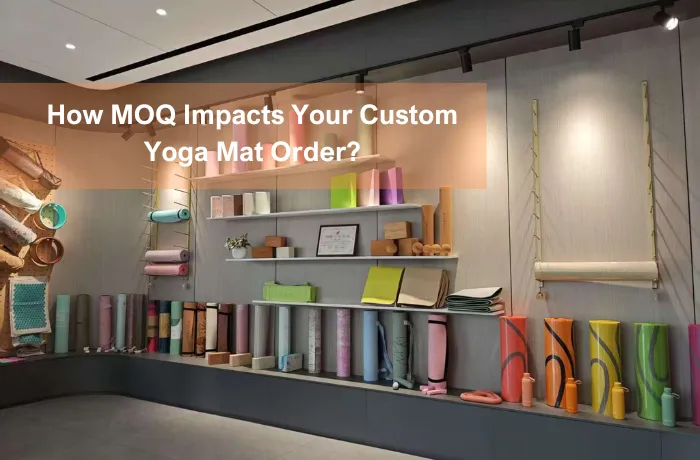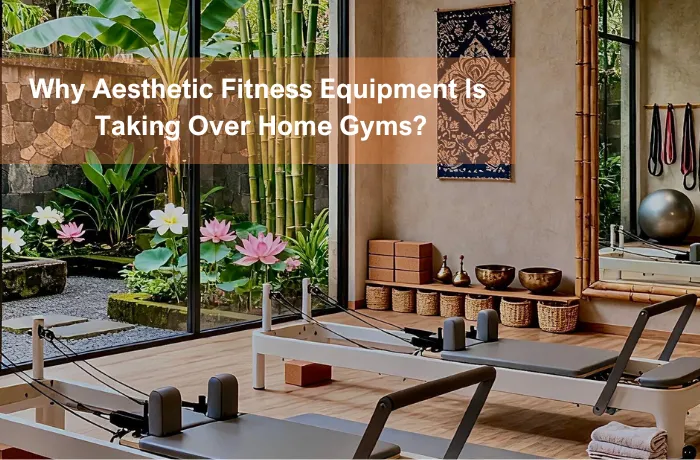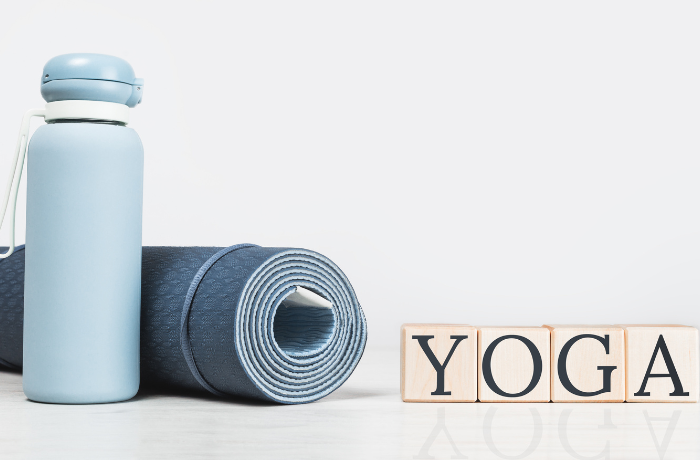
You often find the ideal yoga mat thickness falls between 4 and 6 mm. Beginners usually look for maximum comfort, so you might prefer a yoga mat with 5-6 mm mat thickness. Experts often choose a thinner yoga mat, around 3-4 mm, for better stability. The perfect yoga mat thickness depends on your comfort, joint health, and style of practice. When you ask how to choose a yoga mat, think about mat thickness, portability, and joint protection. Your needs will guide you to the right mat thickness.
Key Takeaways
- Most people think yoga mats that are 4 to 6 mm thick are best. These mats give good comfort and help you stay steady in many yoga styles. Beginners like thicker mats, about 5 to 6 mm, because they protect joints. Thicker mats also help keep knees and wrists safe. Experts often pick thinner mats, about 3 to 4 mm, for better balance. Pick your mat thickness by thinking about your yoga style and how your joints feel. Also, think about where you do yoga. Fast yoga works well with thinner mats. Slow, gentle yoga needs thicker mats. The mat material changes how well you grip and how long it lasts. Rubber and TPE mats grip well, even if you sweat. PVC mats last a long time but can lose grip after a while. Try different mats before you buy one. This helps you find the right thickness and feel. Change your mat when it gets old or does not support you anymore.
Yoga Mat Thickness Guide
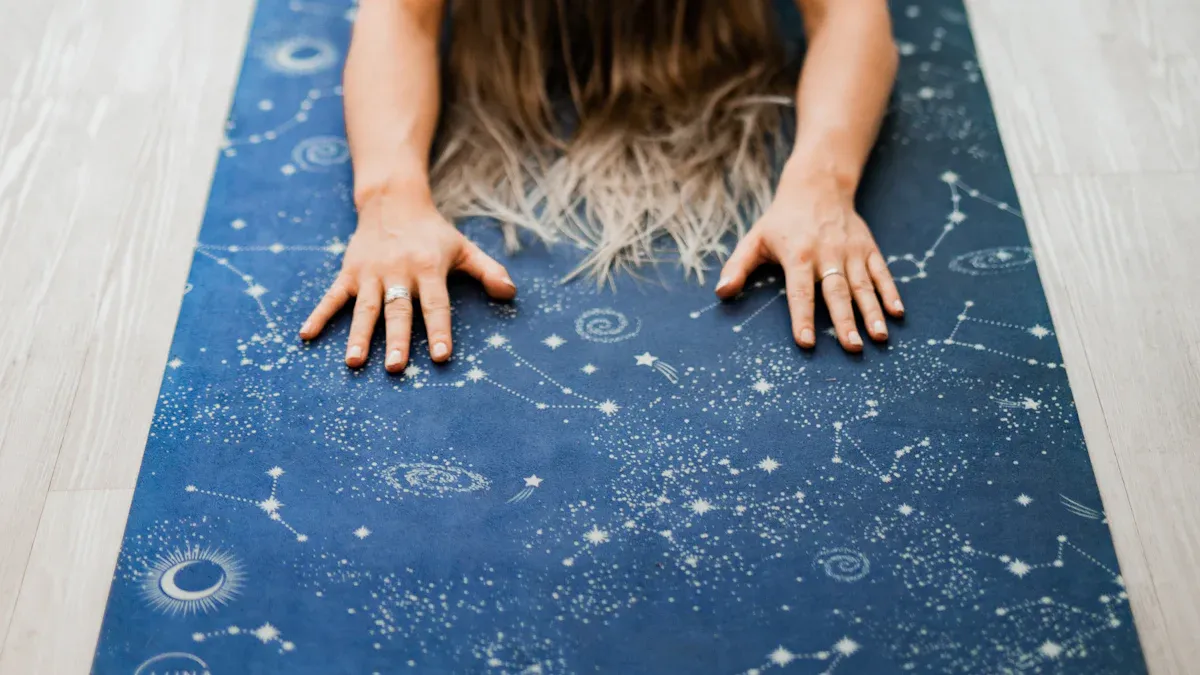
Standard Thicknesses
Yoga mats come in many thicknesses. Each thickness has a special use. Some are better for travel, while others help with comfort. Here are the usual thickness ranges:
| Thickness Range | Description | Typical Use |
|---|---|---|
| 1-2 mm | Ultra-thin mats | Travel, portability, advanced users |
| 3-4 mm | Thin mats | Dynamic yoga, stability focus |
| 4-5 mm | Standard thickness | Versatile, suitable for most styles |
| 6 mm+ | Thick mats | Extra cushioning, joint protection |
Most people pick mats between 4 and 6 mm thick. This thickness gives comfort and keeps you steady. Medium mats in this range are popular. They protect your joints and let you feel the floor. If you want a mat for general use, this range is a safe bet.
Tip: If you do yoga at home on hard floors, a thicker mat can help your knees and wrists.
Thin vs Thick Mats
You might wonder how thin mats and thick mats are different. Thin mats, about 1-3 mm, help you feel the ground. This makes balancing easier in standing poses. Many advanced users and travellers like thin mats. They are light and easy to carry. But thin mats wear out quickly and do not give much padding.
Thick mats, from 6 mm up to 12 mm, are softer and protect your joints. These mats are good for people with sore joints or those who do gentle yoga. Thick mats last longer and do not flatten easily. But very thick mats can make balancing harder. Some people think too much softness changes their posture.
Medium mats, about 4-6 mm thick, are a good middle choice. They give enough padding for comfort and enough firmness for balance. Many yoga teachers and fitness experts suggest this thickness for most people.
- Thin mats (1-3 mm):
- Light and easy to carry
- Good for fast yoga styles
- Not much padding, wears out fast
- Standard thickness (4-6 mm):
- Good mix of support and comfort
- Works for most yoga styles
- Lasts a long time
- Thick mats (6 mm+):
- Lots of padding
- Best for joint care and gentle yoga
- Can make balancing harder
How Thick Should a Yoga Mat Be?
You may ask, how thick should your yoga mat be? The answer depends on how you practise, your joints, and what feels best. If you do fast yoga, like Vinyasa or Ashtanga, you might want a thin mat for better balance. If you need more support for knees or wrists, thick mats are better.
Experts and yoga groups say 4-6 mm is good for most people. This thickness gives enough padding but still lets you balance well. If you travel a lot, a thin mat is easy to pack. If you do yoga at home and want more comfort, thick mats are a good pick.
Note: The material and how dense your mat is also matter. A dense mat can support you even if it is not thick.
When you choose a mat, think about what you need most. Do you want it to be easy to carry, soft for your joints, or a bit of both? Try out different mats if you can. The best mat thickness is the one that feels right for you and your yoga.
Yoga Styles and Mat Choice
Dynamic Yoga
Dynamic yoga styles, such as Vinyasa, Ashtanga, and power yoga, involve quick movements and frequent transitions. You need a mat that helps you stay balanced and steady. Thinner mats, usually between 3 mm and 4 mm, work best for these styles. They give you a firm surface, which helps you feel the floor and maintain balance during fast-paced sequences.
- Thinner mats provide:
- Greater stability for standing and balancing poses
- Better responsiveness, so you can move quickly and safely
- Enhanced proprioception, which means you sense your body’s position better
If you travel often or attend classes outside your home, a thin mat also makes a great travel yoga mat. It folds or rolls up easily and fits in most bags. However, thin mats offer less cushioning, so you may feel the floor more, especially during seated or kneeling poses.
Tip: If you practise dynamic yoga and want to protect your joints, look for a mat with high density. This gives you support without extra thickness.
Restorative Yoga
Restorative yoga focuses on relaxation and long-held poses. You spend more time on the mat, often using props like blankets and bolsters. For this style, you need a mat with extra cushioning. Mats with a mat thickness of 5 mm to 6 mm are ideal. They protect your joints and let your body relax fully.
A thick mat, such as a 5 mm cork mat, offers comfort and a natural feel. The extra padding supports your knees, hips, and elbows during long sessions. You can add blankets for even more comfort. The right mat thickness helps you rest deeply and prevents discomfort in sensitive areas.
Restorative yoga does not require as much balance as dynamic styles. You can choose a thicker mat without worrying about losing stability. This makes thick mats perfect for gentle, slow-paced yoga at home.
Note: Too much mat thickness can make standing poses less stable, but this is not a problem in restorative yoga.
Joint Sensitivity
If you have sensitive joints, you need to pay close attention to mat thickness. Thicker mats, around 5 mm to 6 mm, cushion your knees, wrists, and elbows. This reduces pressure and helps prevent pain during practice. Many people with joint issues prefer mats with extra padding, especially when practising on hard floors.
A thick mat absorbs impact and supports your joints during longer sessions. You can practise for longer without discomfort. However, thick mats may feel less stable during standing poses. You need to balance comfort with stability. Try different mats to find the best mat thickness for your needs.
If you practise both dynamic and gentle yoga, you might want two mats: a thin one for balance and a thick one for comfort. Some people use a thin mat for classes and a thick mat at home.
Remember: Your comfort and safety come first. Choose a mat thickness that supports your joints and matches your yoga style.
Beginners vs Experts
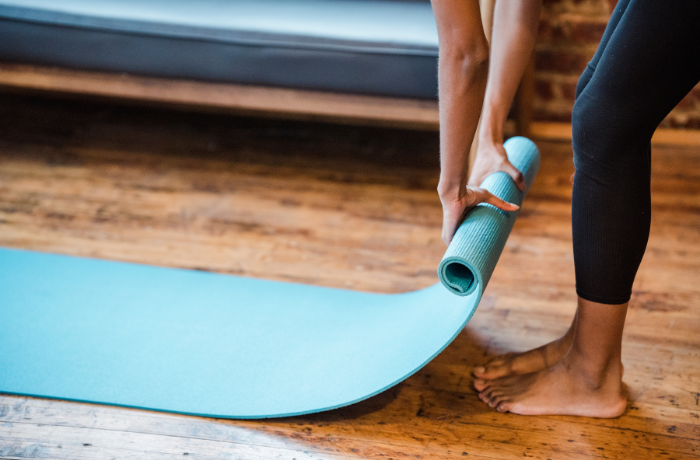
Best for Beginners
When you begin yoga, comfort is very important. You need a mat that feels soft and supports your body. Thicker mats, about 5-6 mm, give extra padding. This helps protect your knees and wrists. Many beginners pick mats like the Gaiam Premium 5mm. These mats are soft and do not cost much. You can learn new poses without hurting your joints. Thick mats are good if you have sensitive knees or practise on hard floors.
Tip: Try out a few mats before you buy one. This helps you find what feels best for your body.
A thick mat works well for slow or gentle yoga. It also helps if your floor is hard. But thick mats can make balancing harder at first. You will get better at balancing as you practise more.
| User Level | Mat Example | Key Needs | Features Highlighted | Pros | Cons |
|---|---|---|---|---|---|
| Beginner | Gaiam Premium 5mm | Affordability, cushioning, comfort | Lightweight, adequate padding, good for balance | Affordable, cushy, lifetime guarantee | Slightly slippery, less durable |
Best for Experts
When you get better at yoga, your needs change. You want a mat that lets you feel the floor. Thin mats, about 3-4 mm, help you balance in hard poses. These mats give you more grip and let you move easily. Experts often use mats like the Manduka PRO or Jade Harmony. These mats are strong and do not slip when wet.
- Thin mats:
- Help you balance in tricky poses
- Let you move fast in dynamic yoga
- Are light and easy to carry
Some experts like mats with lines or bigger sizes. These features help with hard poses and moving between them. Thin mats are good for dynamic or power yoga.
| User Level | Mat Example | Key Needs | Features Highlighted | Pros | Cons |
|---|---|---|---|---|---|
| Expert | Manduka PRO | Grip, durability, size | Fabric-like texture, needs break-in | Sticky when wet, durable, lifetime guarantee | Heavy, expensive |
| Expert | Jade Harmony | Cushioning, traction | Eco-friendly, sticky when wet | Comfortable, good traction, moisture resistant | Latex allergy risk, initial rubber smell |
Common Mistakes
Sometimes, people make mistakes when picking a mat. Many beginners choose mats that are too thick. They think more padding is always better. But thick mats can make it hard to balance. Some experts pick mats that are too thin. These mats might not protect their joints during long sessions.
Note: Always pick a mat thickness that matches your yoga style and comfort. Do not just look at the price or brand.
Other mistakes include forgetting about grip and how long the mat lasts. You need a mat that does not slip and stays strong. Try not to buy mats that wear out quickly. The right mat thickness helps you enjoy yoga and stay safe.
More Yoga Mat Factors
Material and Grip
The material of your yoga mat changes how safe and comfy it feels. Each material has its own good points. The table below shows what makes each one special:
| Material Type | Key Attributes | Market Position / Consumer Preference | Quantitative Insights |
|---|---|---|---|
| PVC | Cheap, strong, easy to clean | Most common, good for saving money, used in gyms | Big market share but less popular with eco-friendly people because of health and environment worries |
| TPE | Light, safe, can be recycled, great grip | More people who care about the planet like it | More people buy it now because it is better for the earth and has good grip |
| Rubber (natural & synthetic) | Best grip and soft feel | Liked for hard workouts, seen as high quality | Not many people use it yet, but it is growing because it is green and works well; costs more so not everyone buys it |
| Cotton/Jute | Natural, lets air through, soaks up sweat | Used by people who love natural things, good for hot yoga | Not many people use it, but those who do like that it is organic; does not last as long and needs more care |
Yoga mats made from TPE, rubber, or jute are now more popular because people want to help the planet. Tests show that rubber mats keep their grip even when wet, so they are great if you do not want to slip. Rubber mats soak up sweat, which helps you stay steady, but PVC mats use their surface to stop slipping. Mats with bumps or lines help move sweat away and make them less slippery. If you do power yoga or hot yoga, you need a mat that stays grippy when you sweat.
Tip: The main grip comes from the mat’s material, not just sticky layers. Rubber mats often get grippier with use, but PVC and TPE mats can lose grip over time.
Durability
You want your mat to last a long time. How long it lasts depends on what it is made of and how you look after it. PVC mats can last for years and sometimes have long guarantees. Rubber mats also last a long time and keep working well. TPE mats last about one to three years, and EVA foam mats wear out fast. The table below shows how long each type lasts:
| Material | Lifespan (with regular use) | Durability Notes |
|---|---|---|
| PVC | Lasts for years | Very strong, keeps its shape; some like Manduka PRO have a 10-year guarantee. |
| TPE | 1-3 years | How you clean it matters; strong cleaners make it wear out faster. |
| Natural Rubber | Lasts a long time | Comes from trees that live 30-35 years; works well for many years. |
| NBR Synthetic Rubber | 1-4 years | Does not last as long as real rubber. |
| EVA Foam | Not very strong | Gets dents and wears out fast; needs to be replaced more often. |
You can help your mat last longer by cleaning it often and keeping it away from sunlight. Do not let sharp things like rings or nails touch it, as they can scratch it. Eco-friendly mats can last just as long as other mats if you take care of them.
Yoga Exercise Mat Portability
If you travel or go to classes, you need a mat that is easy to carry. Light mats are simple to move around. Many travel mats fold or roll up to fit in your bag. Small mats are great for trips on planes, trains, or cars. What the mat is made of also changes how heavy it is. Rubber mats are heavier, but TPE and cotton mats are lighter. Some mats do not tear easily and do not soak up sweat, so they last longer when you travel.
- Foldable mats fit in bags easily.
- Light mats are simple to carry.
- Mats that do not slip keep you safe in new places.
- Mats without bad smells make travel nicer.
- Mats that are easy to clean help you stay healthy.
You may want a mat that does not slip when you travel, as you might use it on many types of floors. Travel mats are usually thinner but still feel comfy. Pick a mat that is both easy to carry and soft enough for you.
Perfect Yoga Mat Thickness Tips
Testing Mats
You can find the perfect yoga mat thickness by testing mats before you buy. Try different mats in real yoga poses. Stand, kneel, and sit on each mat. Notice how your joints feel. Some mats feel soft at first but may not support you during a long session. You should check the grip and see if your hands or feet slip. Move through a few poses to test stability.
- Try mats in real practice, not just in the shop.
- Read user reviews online. People share their experiences with comfort, grip, and durability.
- Compare brands for thickness, material, and eco-friendliness.
- Ask friends or teachers for recommendations.
Tip: Your comfort during a short test may change after a full class. Always try to practise for a few minutes on each mat.
You may need to experiment. The perfect yoga mat thickness depends on your style, joint health, and how much support you want. Thicker mats protect your joints but may make balancing harder. Thinner mats help you feel the floor and improve balance.
When to Upgrade?
You might notice signs that it is time to upgrade your mat. Mats wear out with regular use. If your mat feels thin in places or you start to slip, you may need a new one. Cracks, peeling, or a loss of grip also show that your mat is past its best.
- Upgrade if you change your yoga style or need more support.
- Replace your mat if it smells bad or does not clean well.
- Choose a new mat if your old one no longer feels comfortable.
Note: Your needs can change as you grow in your practice. You may want to try a different thickness as you become more experienced. The perfect yoga mat thickness for you now may not be the same in a year.
Choosing the right yoga mat thickness helps you enjoy your practice and protect your joints. Most people find a mat between 4 and 6 mm works best. Your comfort, yoga style, and joint health matter most.
- Test different mats to see what feels right.
- Focus on your needs, not just trends or brands.
- Review your mat choice as your practice grows.
Remember: The perfect mat supports your journey, not just your poses. 🧘♂️
FAQ
What thickness is best for yoga beginners?
You should start with a mat between 5 mm and 6 mm. This thickness gives you comfort and protects your joints. You will find it easier to learn poses without hurting your knees or wrists.
Can a thick yoga mat make balancing harder?
Yes, a thick mat can make balancing more difficult. You may feel less stable during standing poses. If you want better balance, try a mat between 3 mm and 4 mm.
How do I clean my yoga mat?
Wipe your mat with a damp cloth after each use. Use mild soap and water for a deeper clean. Let your mat air dry before rolling it up.
Is a travel yoga mat good for daily practice?
Travel mats are light and easy to carry. They work well for trips or classes. For daily home practice, you may want a thicker mat for more comfort and support.
Does mat material affect grip?
Yes, the material changes how much grip you get. Rubber and TPE mats often give you better grip, especially when you sweat. PVC mats can lose grip over time.

